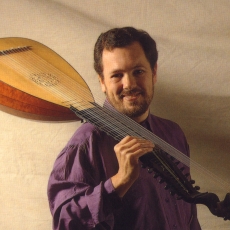
Bach - Nigel North - MusicWeb International
It must be frustrating to play the lute if you're a Bach lover. The amount of music Bach wrote for lute is very limited; it fits on a mere two CDs. While this oeuvre is, perhaps, the most impressive of the baroque period, once you're recorded it, you're all out of Bach. More and more lutenists, and guitarists, are now turning to transcriptions of Bach's other instrumental works that are suitable for the lute. These are limited to another small group: the sonatas and partitas for solo violin, and the cello suites. Nigel North, one of today's most interesting lutenists, here presents transcriptions of these works in a 4-CD set, which is a re-release of earlier discs.
Those unfamiliar with the instrument may wonder, however, what justification there is for transcribing such works for a radically different instrument; plucked rather than bowed? Well, since many of Bach's lute works were already transcriptions of other works there is certainly justification for this. Take the examples of the fugue BWV 1000, which is a transcription of the second movement of the BWV 1001 sonata; or the G minor suite for lute, BWV 995, which is a transcription of the BWV 1011 cello suite. And, since many of the works that Bach himself transcribed come from this body of violin and cello works, there are already clues as to how to transcribe the remaining pieces.
North, in the liner-notes to this set, points out how some of the works "feel natural and satisfying ... to play on the lute", and how others are more "awkward to play". North performs all but two of the violin works in their original keys; changes were needed to "fit" these pieces for the lute. His transcriptions are, of course, his own, and one might wish to quibble with certain voicings and phrasings here and there, but it is best to approach them as unique pieces of music and not compare them with the originals.
Listening to these works, one cannot ignore the peaceful tone that comes from the lute, unlike the broader dynamics of the violin or cello, but also the lovely resonance that is apparent in the instrument used for these recordings. The recording bears none of the artificial reverberation that is often hear with such "weak" instruments, and sounds close and rich. North's tempi are lively and the instrument loses no detail in the faster passages.
Personally, these works are among my favourites of all of Bach's music. The sonatas and partitas present a varied group of styles and tones - ranging from the marvellous fugue in the first sonata to the well-known chaconne in the second partita. This is a catalogue of forms and styles. The cello suites are much more ordered in their structure, in the "French" form, with preludes and five dances for each suite. But taken altogether, over these four discs, the works take on a homogeneity that one cannot hear with the original instruments. Bach's different styles for the two original instruments come together here in a single form that works quite well.
North is naturally not the first performer to transcribe these works. Paul Galbraith has notably recorded the sonatas and partitas for eight-string guitar; Hopkinson Smith has recorded them as well, along with several of the cello suites; and Pascal Montheilet has recorded all the cello suites for theorbo. This is to point out how these works fit well to plucked instruments. Naturally, the rapid decay of gut strings changes the music, especially in the slower movements of the cello suites, but the result is never that of a poor relation to the original; North's recordings give you all the music, just differently. It is a huge pleasure to listen to this set, to discover new intricacies in the music that the lute can highlight more than bowed instruments, and to have the simple joy of hearing what is extremely peaceful music; I except some of the faster movements, such as the chaconne of the BWV 1004 partita. I feel the cello suites work better on plucked instruments, in general, but this is not to say that the violin works are not successful; it is simply, perhaps, that the difference is more apparent, with the violin being further from the lute's range.
All in all, this is a lovely set, the result of great attention to the music and very detailed performance. The recording quality is excellent and getting all four of these discs at such a low price is a great bargain. North is in his element here, with sensitive playing and overall fine transcriptions that do not change Bach's music, but rather adapt it to this beautiful instrument.